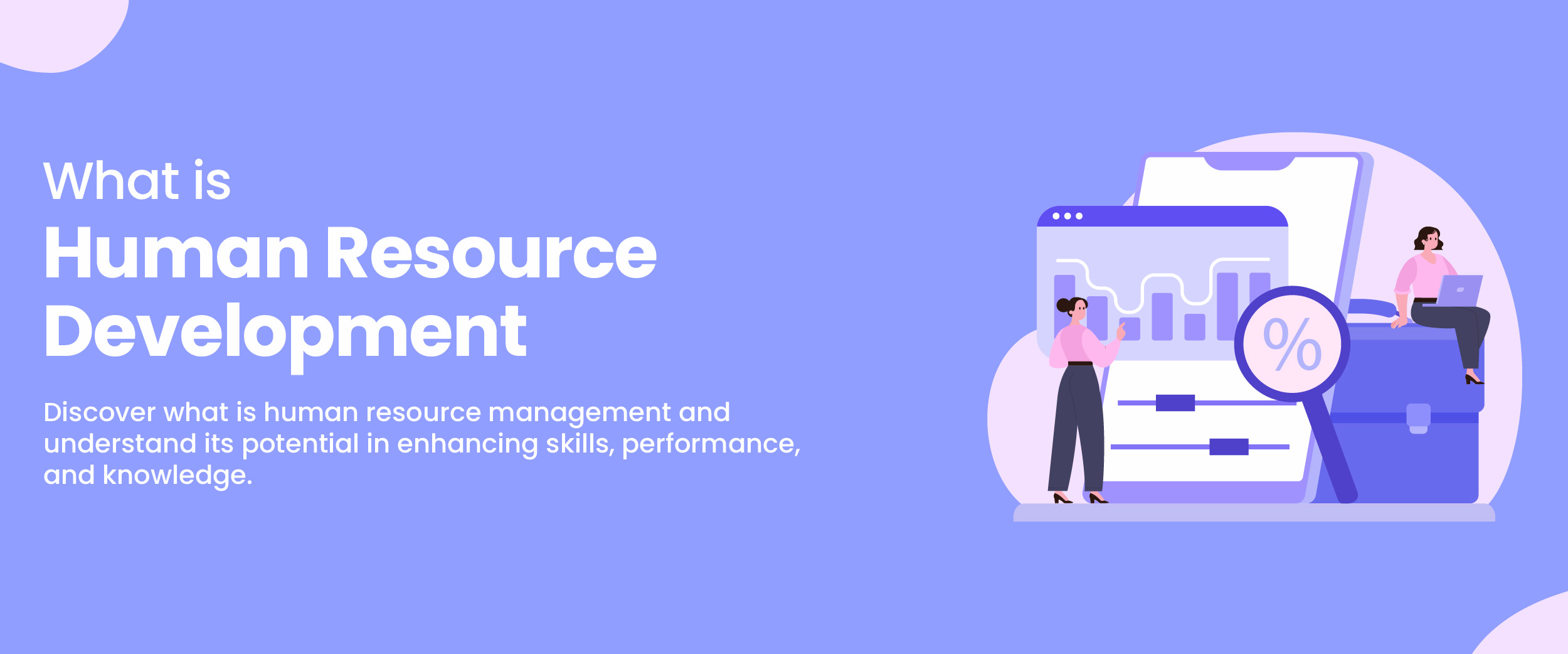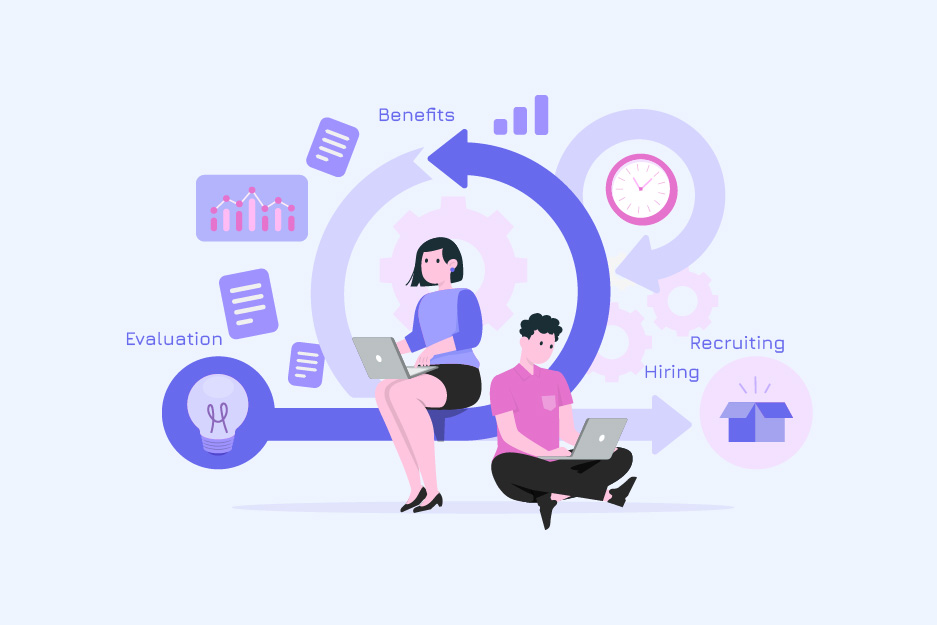What is Human Resource Development: All You Need to Know
Did you know that 47% of organizations possess a comprehensive human resource development plan? HRD is a framework of the human resource department consisting of various methods to improve the performance of employees through effective training. It refers to a group of training programs and initiatives that help employees in comprehending the demands of their new roles.
In this blog, we will learn about what is human resource development, its objectives, and how it can benefit employees and organizations.
So before starting with the complete concept of human resource development, let’s learn the definition of HRD.
About Human Resource Development
HRD deals with the training of employees within the company. For any organization that wants to be dynamic and growth-oriented, these resources play a crucial role. It primarily includes:
- Training employees after they are hired.
- Giving them the chance to learn new skills.
- Providing them with resources helpful for their tasks.
- Engaging in other developmental activities.
The following are the two major categories of HRD.
Formal HRD:
Businesses can hire a consultant to carry forward HRD efforts. Coursework and intense training programs can be included in the formal HRD procedure.
Informal HRD
Managers can serve as mentors to guide their new team members. They can also play an active role in the onboarding procedure. In contrast to the formal HRD process, the informal HRD may or may not have a proper schedule or method of training.
Worried about How to get a job in HR? explore our human resource placement guarantee course.
Elements of Human Resource Development
Now that you know the meaning of human resource development let’s discuss the three major elements of HRD that help human resources strategize for the overall development of the company and its employees. These elements are as follows:
Individual Development
This element focuses on the individual development of an employee within an organization. The employees are trained to improve their existing knowledge and skills or develop new ones to help them grow as a person and adapt to the workplace.
Organizational Development
This element focuses on creating corporate strategies that aim to improve the entire workforce and overall operations of the organization. It increases the productivity and efficiency of the organization as a whole.
Career Development
This element focuses on the development aimed at the requirements of the future trajectory of an employee’s career. It involves analyzing and identifying individual interests and competencies required to develop skills and improve employees’ careers.


Examples of HR Development
Every organization utilizes different methods of HR development, depending on their employees, objectives, expectations, and budget. Some examples of human resource development are:
- Mentoring Programs: Under this method, the senior employees mentor the junior employees, especially the recruits, to help them understand their work responsibilities and adjust to the workplace.
- Goal Management Training: This training involves personal assessment where each employee sets their objectives. A supervisor ensures that the objectives align with the organization’s goals to promote the company’s growth.
- Classroom Learning: In this method, a lecture or workshop is organized to provide work-related knowledge to employees. This is a form of group training.
- On-the-Job Training: This method involves helping the employees acquire the necessary skills and knowledge through practical work experience or on-the-job training. There are more chances of immediate promotion through these training sessions.
- Job Rotation: Under this method, the employees are reassigned to different departments to develop their skills. The HR department strategically plans these rotations to promote long-term growth among the employees.
Importance of Implementing Human Resource Development
Implementing HRD in an organization can provide various benefits; these include:
- Increases Work Caliber: HRD programs primarily instruct employees on how to carry out their duties quickly and efficiently. This helps increase productivity and work caliber.
- Increases Employee Retention: When new employees feel that their employers support them, they feel more satisfied and comfortable with their jobs. This will ensure that such employees stay longer in the company. High employee retention rates can also help HRs save time and money.
- Effective Work Relationships: HRD procedures ensure that new employees get to know their co-workers. It also involves making sure the employees are comfortable contacting their managers.
- Quick Change Implementation: HRD procedures can lessen employee resistance to new policies or practices. Employees can adapt to innovations and grasp a better understanding of organizational goals.
- Encourages Workplace Collaboration: Successful workplace collaboration results from fostered relationships among staff members. By implementing HRD practices, employees can know their co-workers better.
Also, read the importance of HRM for better understanding.
Benefits of Human Resource Development
Some of the crucial benefits of human resource development are:
- Improves Employee Engagement: The human resource development efforts of an organization demonstrate its commitment to employee growth. It makes the employees feel valued, increasing their dedication towards their job roles.
- Fosters Learning Culture: Human resource development helps foster a learning culture in the organizations, promoting a growth mindset, creativity, collaboration efforts, etc. It also helps employees navigate new opportunities.
- Supports Leadership Planning: An organization can nurture future leaders with the help of HRD initiatives. These aim to provide aspiring leaders with the necessary skills and knowledge to ensure a smooth leadership transition in the future.
Objectives of Human Resource Development
The following are the objectives of HRD.
- To give employees the tools they need to meet their current and future employment needs.
- To enhance and broaden one’s creativity at work.
- To prepare employees for their future roles.
- To impart knowledge and fundamental skills of HRD to new employees.
- To provide a sense of belonging and accountability in the workplace.
- To make sure that the business is productive and efficient.
- To increase organizational capabilities.
Tips to Implement Successful HRD
Below is a thorough guide to implementing human resource development and achieving the best possible outcomes for any organization. To better understand the objectives and processes of HRD, you can take an advanced HR course.
1. Frequent Check-ins
Schedule regular sessions with new employees. You can also perform straight check-ins by analyzing their progress toward your organizational goals. This will help build an ongoing learning environment.
Another step to performing check-ins is through weekly meetings. They can be planned between mentors and employees for an informal discussion.
2. Small Steps
Implement the procedures slowly so that employees don’t find it overwhelming. While at it, ensure your plans are aligned with the organizational goals. By adding too many new concepts and abilities at once, you can run the risk of increasing employees’ workload.
You can also offer new employees a variety of learning strategies. These strategies include accommodating schedules, knowing learning preferences, and offering unique development objectives.
3. Continuous Feedback
The giving and receiving of feedback is a continuous and two-way process. The mentors and managers can plan to give regular input to the employees. On the other hand, employees can also ask for opinions from their co-workers.
4. Understanding Unique Characteristics
HRD plans must be designed and carried out by keeping in mind that people learn differently. For example, some employees prefer audio or visual aids to understand concepts. On the other hand, some require a more practical approach to understand the same concepts.
5. Extend Gratitude
Extend genuine gratitude towards the employees. To do so, use tokens of appreciation and recognition, such as badges and certificates. You can also make use of verbal reassurances whenever possible. This also helps motivate the rest of the employees.
Explore our blog on human resource planning for better planning and development.
Human Resource Development vs. Human Resource Management
Human resource development and human resource management are two different but essential elements of the human resources division of an organization. Let us explore the key differences between the two:
| Parameter | Human Resource Development | Human Resource Management |
| Definition | It is the process of enhancing the knowledge, skills, and capabilities of an organization’s workforce. | It is the practice of efficient and effective management of an organization’s employees. |
| Objective | It improves the productivity and performance of employees. | It maintains a healthy work culture, accomplishing organizational goals and employee motivation. |
| Scope | It includes training and development, organizational development, career planning, and talent management. | It includes recruitment, employee relations, compliance with laws, and performance management. |
| Time | It comprises long-term goals. | It comprises short-term goals. |
| Orientation | It is employee-oriented as it focuses on the growth and progression of employees’ careers. | It is organization-oriented as it focuses on efficiency within the organization and better resource management. |
Conclusion
Human resource development helps employees enhance their skills and prepare for future jobs. It aims to improve each employee’s learning process while creating a positive work culture in an organization. As we learned the human resource development concept in detail, use these tips and techniques in developing your strategies to achieve your organizational goals.
Which method is most effective in implementing HR development according to you? Share your answers with us in the comments section below. If you are interested in joining the workforce as an HR professional, check out the top HR interview questions to prepare for your interview.
FAQs
Human resource development aims to enhance the knowledge, skills, and abilities of the employees in an organization to increase productivity and efficiency.
The human resource development process involves personal development, professional development, performance management, and organizational development. It is carried out by a variety of techniques, such as training, coaching, mentoring, job rotation, etc.
Human resource development is essential in an organization because it helps in training the employees and enhancing their skills and abilities, which results in improved performance. It ensures better adaptability of the organizational culture and achievement of the organization’s objectives.
Some of the main features of human resource development are:
a) A systematic process that aims at the continuous development of an organization’s workforce.
b) Various training methods to provide comprehensive development of employees.
c) The creation of a healthy work culture.
d) The facilitation of succession planning.







